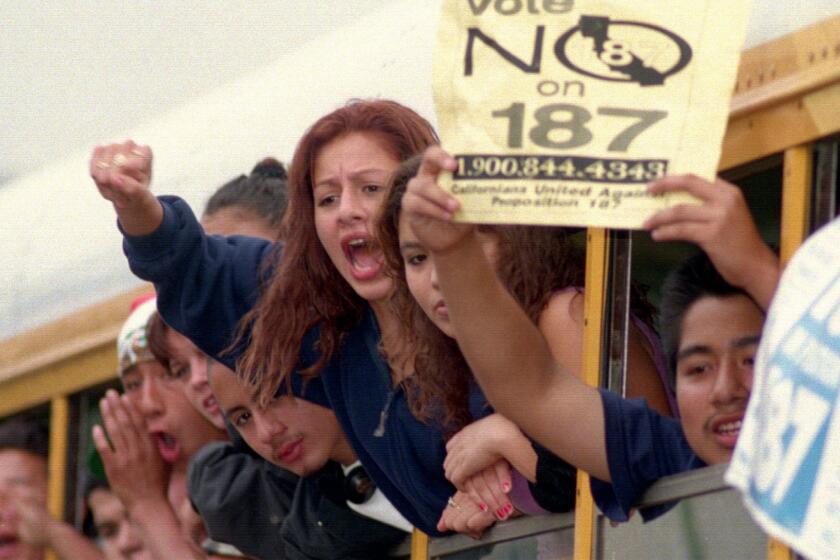Column: We now live in a Prop. 187 America. What’s next?

- Share via
We tell ourselves stories in order to live, Joan Didion famously wrote, and the one Democrats in California repeated for decades was Proposition 187.
Californians of a certain age can recite it by heart: A 1994 ballot initiative sought to make life miserable for undocumented immigrants, with proponents claiming that unchecked migration was destroying the Golden State by burdening social services and changing the demographics of cities. It passed with nearly two-thirds of the vote, despite opponents denouncing it as racist and protests across the state that drew hundreds of thousands.
That was the darkness before the light for Dems: While Republicans won the Prop. 187 battle, they ended up losing the war.
The ACLU and the Mexican American Legal Defense and Educational Fund sued to stop the proposition from becoming law, and a federal judge eventually ruled it unconstitutional in 1998, with then-California Atty. Gen. Dan Lungren withdrawing the state’s appeal the following year.
A look back at the events surrounding the 1994 proposition.
By then, Latinos — who were the primary target of Proposition 187 and its noxious ads — were running for office as Democrats in record numbers. Within a decade, the California GOP had largely withered away in Sacramento as the state became more diverse. By 2012, Democrats achieved a supermajority in the state legislature that they have rarely relinquished since.
Proposition 187’s lessons seemed so obvious that a 2013 Republican National Committee report concluded that the party needed to tone down its anti-immigrant language lest “our Party’s appeal … continue to shrink to its core constituencies” of angry, older gringos.
On the proposition’s 25th anniversary in 2019, the California Latino Legislative Caucus recorded an ad that mockingly thanked former Gov. Pete Wilson — who hitched his sagging campaign onto 187 to pull off a comeback victory — for getting them into power. That year, I also hosted “This is California: The Battle of 187,” a one-hour podcast about the proposition’s legacy.
I was part of that generation of Latinos who forsook the Republican Party. I’ve talked about how that shift reshaped the California political landscape in dozens of lectures, articles and interviews over the last two decades. As I developed the podcast, though, I realized there was an important part that too many historians, politicians and activists rarely focused on: the fact that Proposition 187 overwhelmingly passed in the first place.
They dismissed the measure’s victory as the last gasp of a white electorate and reassured Latinos who lived in states that spawned dozens of copycat laws, measures and politicians by retelling the Democratic triumphalist part like it was gospel. Their prediction was that the blue wave that engulfed California would spread across the country if Republicans dared to campaign on anti-immigrant politics ever again.
And here we are.

Donald Trump and his vice president, JD Vance, staged the most anti-immigrant presidential campaign in modern times, spreading lies about Haitian refugees eating cats in Vance’s home state of Ohio and complaining that recent arrivals were “poisoning the blood of our country.”
They nevertheless easily beat Kamala Harris and Tim Walz — or rather, they won with the help of their hate. Exit polls showed that Trump — who began his first run in 2015 by declaring that Mexicans coming over the border were “rapists and drug dealers” — increased his share of the Latino vote for the second straight election, this time doing better than any GOP presidential candidate since the statistic has been tracked.
While opponents predicted that Trump’s vitriol would propel the Harris-Walz ticket to the White House, he learned well from the old Proposition 187 advocates he roped into his first campaign to speak about how unchecked migration had wreaked havoc on California. He understood that trashing immigrants tapped into the American primordial fear of newcomers, a phobia so potent that right now, the Democratic takeover of California after Proposition 187 looks more like an exception than a rule.
We now live in a Prop. 187 America — and in many ways, one that is even more receptive to anti-immigrant politics than 30 years ago.
Latinos oppose open borders in far higher numbers now than they did then. As I wrote in a previous columna, 23% of Latinos and 63% of whites voted for Proposition 187, while a UC Berkeley Institute of Governmental Studies poll co-sponsored by The Times this year found that 63% of Latinos in California consider undocumented immigrants to be a “burden,” compared with 79% of whites. Even Harris had to swing rightward on immigration policy to try to keep up with Trump.
This hardening by Latinos doesn’t surprise me one bit. In a state where an estimated 83% of Latinos are of Mexican heritage, the changing faces of illegal immigration are drawing less and less empathy. I’ve seen this within my own family.
The text of Proposition 187 said nothing about deporting undocumented immigrants, only that local law enforcement and public workers should alert immigration authorities if they suspected someone didn’t have legal status. Trump, on the other hand, has vowed to deport every illegal immigrant, no matter the cost, while his immigration consigliere, Santa Monica native Stephen Miller, has previously explored banning birthright citizenship and deporting immigrants for their activism. Miller will no doubt pursue those measures and more, with news outlets reporting that he will be Trump’s deputy chief of staff.
There was even a son-of-187 on the ballot this year: Arizona’s Proposition 314, which would have allowed local law enforcement to arrest immigrants who are in the country illegally. The state has become more purple over the last decade, a shift that pundits long attributed to the Latino backlash over SB 1070, a 2010 anti-immigrant bill.
In a year where Trump won Arizona with just 52% of the vote and Democratic Rep. Ruben Gallego was just voted in as the state’s first Latino U.S. senator, 63% of voters sided with Proposition 314. It even carried Arizona’s two majority-Latino counties, Santa Cruz and Yuma.
The Democratic circular firing squad is already in full effect, but one of the questions party leaders in California should ask themselves is if retelling their version of Proposition 187 ad nauseam has rendered its lessons ineffectual.
The Proposition 187 narrative convinced party leaders nationwide that Latinos would become a bedrock voting bloc as the racism they encountered in other parts of the country drove them toward Democrats. It absolved Democratic leaders of trying to appeal to Latinos, beyond claiming to be less anti-Latino than Trump.
Besides, assuming that Latinos would break the time-honored immigrant tradition of spitting on more recent arrivals was as foolish as thinking that Liz Cheney campaigning alongside Harris would do any good.

Protests are already happening across the country against Trump’s deportation plans. The immigration activists I know are already preparing for things to get way worse before getting even a little bit better. On social media, Trump supporters are already posting the hotline for Immigration and Customs Enforcement to report unauthorized migrants.
What I would remind the incoming president and his followers is that history is ultimately not on their side. For all the claptrap over the decades about booting people out, this country’s leaders quickly realize their error and bust out the proverbial welcome mat just as quickly.
After the Hoover and FDR administrations forced over a million Mexican immigrants and their American-born children to repatriate to Mexico during the Great Depression, a labor shortage led to the bracero program, which legally brought in millions of Mexican workers.
Dwight D. Eisenhower might have launched Operation Wetback in the 1950s to deport hundreds of thousands of Mexicans — a program Trump praised in Time magazine as “very proficient.” But in 1965, Congress loosened immigration restrictions and remade the demographics of this country.
While immigration agents staged highly publicized raids during the 1980s, Democrats and Republicans worked on an amnesty that President Reagan signed into law in 1986. And when Congress tried to pass an anti-immigrant bill in 2006, the largest protests in U.S. history up to that time galvanized a new generation of activists who won protections for so-called Dreamers in the following years.
What I would remind immigrant activists is that the Latino backlash against Proposition 187 was never the silver bullet against xenophobia that too many people made it out to be — and it was frankly hijacked by Democrats.
But it still offers this valuable lesson:
The night is always supposedly darkest before the dawn — and activists are now staring at a black hole seemingly larger than what they faced in 1994.
But folks 30 years ago eventually found the light to move forward. Because light always shines in the darkness, and the darkness can never comprehend that.
More to Read
Sign up for Essential California
The most important California stories and recommendations in your inbox every morning.
You may occasionally receive promotional content from the Los Angeles Times.













